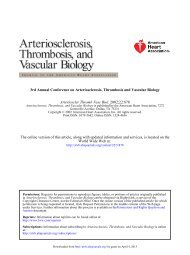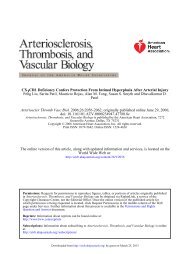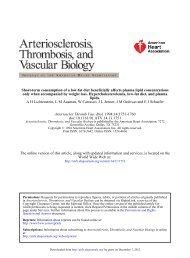Bloch and Richard T. Lee P. Christian Schulze, Heling Liu, Elizabeth ...
Bloch and Richard T. Lee P. Christian Schulze, Heling Liu, Elizabeth ...
Bloch and Richard T. Lee P. Christian Schulze, Heling Liu, Elizabeth ...
You also want an ePaper? Increase the reach of your titles
YUMPU automatically turns print PDFs into web optimized ePapers that Google loves.
Nitric Oxide–Dependent Suppression of<br />
Thioredoxin-Interacting Protein Expression Enhances<br />
Thioredoxin Activity<br />
P. <strong>Christian</strong> <strong>Schulze</strong>, <strong>Heling</strong> <strong>Liu</strong>, <strong>Elizabeth</strong> Choe, Jun Yoshioka, Anath Shalev,<br />
Kenneth D. <strong>Bloch</strong>, <strong>Richard</strong> T. <strong>Lee</strong><br />
Objective—Cellular redox balance is regulated by enzymatic <strong>and</strong> nonenzymatic systems <strong>and</strong> freely diffusible nitric oxide<br />
(NO) promotes antioxidative mechanisms. We show the NO-dependent transcriptional regulation of the antioxidative<br />
thioredoxin system.<br />
Methods <strong>and</strong> Results—Incubation of rat pulmonary artery smooth muscle cells (RPaSMC) with the NO donor compound<br />
S-nitroso-glutathione (GSNO, 100 mol/L) suppressed thioredoxin-interacting protein (Txnip), an inhibitor of<br />
thioredoxin function, by 7118% <strong>and</strong> enhanced thioredoxin reductase 2.70.2 fold (n6; both P0.001 versus<br />
control). GSNO increased thioredoxin activity (1.90.5-fold after 4 hours; P0.05 versus control). Promoter deletion<br />
analysis revealed that NO suppression of Txnip transcription is mediated by cis-regulatory elements between 1777 <strong>and</strong><br />
1127 bp upstream of the start codon. Hyperglycemia induced Txnip promoter activity (3.90.2-fold; P0.001) <strong>and</strong><br />
abolished NO effects (37.41.0% at 5.6 mmol/L glucose versus 12.42.1% at 22.4 mmol/L glucose; P0.05).<br />
Immunoprecipitation experiments demonstrated that GSNO stimulation <strong>and</strong> mutation of thioredoxin at Cys69, a site of<br />
nitrosylation, had no effect on the Txnip/thioredoxin interaction.<br />
Conclusions—NO can regulate cellular redox state by changing expression of Txnip <strong>and</strong> thioredoxin reductase. This<br />
represents a novel antioxidative mechanism of NO independent of posttranslational protein S-nitrosylation of<br />
thioredoxin. (Arterioscler Thromb Vasc Biol. 2006;26:2666-2672.)<br />
Key Words: atherosclerosis diabetes mellitus nitric oxide oxidative stress thioredoxin<br />
The thioredoxin system is a ubiquitous thiol-reducing<br />
system that includes thioredoxin, thioredoxin reductase,<br />
<strong>and</strong> NADPH. 1 The thioredoxin system is an essential component<br />
of cellular redox balance, <strong>and</strong> targeted deletion of the<br />
thioredoxin gene in mice leads to early embryonic lethality. 2<br />
In addition to its antioxidative function, thioredoxin mediates<br />
anti-apoptotic effects through interaction with apoptosissignaling<br />
kinase-1 (ASK-1) mediating its ubiquitindependent<br />
degradation. 3,4 Furthermore, thioredoxin functions<br />
as a transcriptional co-activator through interaction with<br />
transcription factors such as NF-B <strong>and</strong> ref1. 5,6 The thioredoxin<br />
system is inhibited by thioredoxin-interacting protein<br />
(Txnip), which blocks thioredoxin’s antioxidative function. 7–9<br />
Several studies have identified Txnip as a critical regulator of<br />
diverse signaling events in mammalian cells because of its<br />
direct control of thioredoxin activity. 10–13 Recently,<br />
S-nitrosylation of thioredoxin at Cys69 has been identified as<br />
a posttranslational mechanism enhancing thioredoxin antioxidative<br />
<strong>and</strong> anti-apoptotic activity both in vitro14 <strong>and</strong> in vivo. 15<br />
Nitric oxide (NO) has diverse functions including vasodilator,<br />
neurotransmitter <strong>and</strong> anti-thrombotic activities. 16 In the<br />
cardiovascular system, the main physiological source of NO<br />
is the endothelium, although other cell types may be induced<br />
to synthesize NO, particularly after exposure to inflammatory<br />
cytokines. 17 NO relaxes smooth muscle cells <strong>and</strong> controls<br />
vascular cell proliferation, migration, <strong>and</strong> apoptosis. 18 Further,<br />
NO has antioxidative properties that remain incompletely<br />
understood.<br />
Here we report that expression of the gene encoding Txnip<br />
is robustly suppressed by NO in rat pulmonary artery smooth<br />
muscle cells (RPaSMC). NO did not affect Txnip mRNA<br />
stability. Hyperglycemia enhanced Txnip expression <strong>and</strong><br />
abolished NO’s suppressive effects; this induction was mediated<br />
by a carbohydrate-response element which was not<br />
responsive to exogenous NO. Further, NO simultaneously<br />
induced expression of thioredoxin reductase. The net effect of<br />
these transcriptional effects was to increase thioredoxin<br />
Original received September 28, 2005; final version accepted September 13, 2006.<br />
From Cardiovascular Division (P.C.S., J.Y., R.T.L.), Department of Medicine, Brigham <strong>and</strong> Women’s Hospital, Harvard Medical School, Boston,<br />
Mass; Cardiovascular Research Center (H.L., E.C., K.D.B.), Massachusetts General Hospital, Harvard Medical School, Charlestown, Mass; Department<br />
of Medicine (A.S.), University of Wisconsin-Madison, Madison, Wis.<br />
Current affiliation for P.C.S. is Department of Medicine, Boston University Medical Center, Boston, Mass.<br />
Correspondence to P. <strong>Christian</strong> <strong>Schulze</strong>, MD, PhD, Department of Medicine, Boston University Medical Center, 80 E Concord St, Evans 124, Boston,<br />
MA 02115-2526. E-mail christian.schulze@bmc.org<br />
*P.C.S. <strong>and</strong> H.L. contributed equally to this work.<br />
© 2006 American Heart Association, Inc.<br />
Arterioscler Thromb Vasc Biol. is available at http://www.atvbaha.org DOI: 10.1161/01.ATV.0000248914.21018.f1<br />
Downloaded from<br />
http://atvb.ahajournals.org/ 2666 by guest on July 30, 2013














